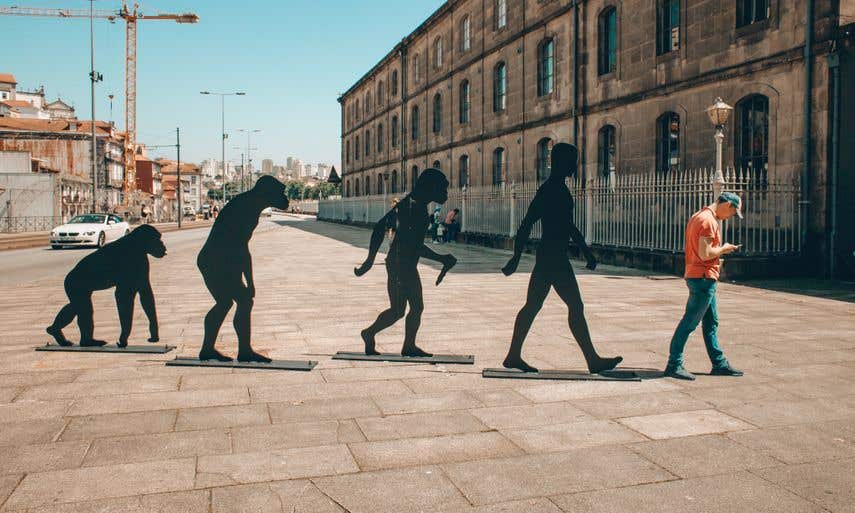Humans continue to evolve with the emergence of 155 new genes
Modern humans evolutionarily split from our chimpanzee ancestors nearly 7 million years ago, yet we are continuing to evolve.

[Dec. 22, 2022: Thomas Deane, Trinity College Dublin]
It will be very interesting in future studies to understand what these microgenes might do and whether they might be directly involved in any kind of disease. (CREDIT: Creative Commons)
Modern humans evolutionarily split from our chimpanzee ancestors nearly 7 million years ago, yet we are continuing to evolve – with new analyses conducted by scientists from Trinity highlighting that two new human-specific “microgenes” have arisen from scratch.
Taking a previously published dataset of functionally relevant new genes, the scientists created an ancestral tree comparing humans to other vertebrate species. They tracked the relationship of these genes across evolution and found 155 that popped up from regions of unique DNA.
“This project started back in 2017 because I was interested in novel gene evolution and figuring out how these genes originate,” says Nikolaos Vakirlis, a scientist at the Biomedical Sciences Research Center “Alexander Fleming” in Vari, Greece, and first author of the journal article that has just been published in the journal Cell Reports.
“It was put on ice for a few years, until another study got published that had some very interesting data, allowing us to get started on this work.”
Related Stories
Aoife McLysaght, Professor in Trinity’s School of Genetics and Microbiology and senior author said: “It was quite exciting to be working in something so new. When you start getting into these small sizes of DNA, they're really on the edge of what is interpretable from a genome sequence, and they're in that zone where it's hard to know if it is biologically meaningful.”
Yet of the 155 new genes (some of which are ancient, some recent), 44 are associated with growth defects in cell cultures, demonstrating the importance of these genes in maintaining a healthy, living system.
Because these genes are human specific, it makes direct testing difficult. Researchers must seek another way to explore what effects these new genes may have on the body, leaving Vakirlis and his team to examine patterns found within the DNA that can hint at the roles these genes play.
De novo birth of functional microproteins in the human lineage. Graphical Abstract. (CREDIT: Cell Reports)
Three of these 155 new genes have disease-associated DNA markers that point to connections with ailments such as muscular dystrophy, retinitis pigmentosa, and Alazami syndrome.
And apart from disease, the researchers also found a new gene that is associated with human heart tissue. This gene emerged in human and chimps right after the split from gorillas and shows just how fast a gene can evolve to become essential for the body.
Reconstructing the phylogenetic origins of human microproteins. Graphical example of reconstruction of the timings of origination of the ORF and of transcription for two hypothetical human microproteins. (CREDIT: Cell Reports)
“It will be very interesting in future studies to understand what these microgenes might do and whether they might be directly involved in any kind of disease,” said Vakirlis.
Professor McLysaght added: “These genes are convenient to ignore because they're so difficult to study, but I think it'll be increasingly recognised that they need to be looked at and considered. If we're right in what we think we have here, there's a lot more functionally relevant stuff hidden in the human genome.”
Chromosomes and Genes. (CREDIT: U.S. National Library of Medicine)
What is a gene?
A gene is the basic physical and functional unit of heredity. Genes are made up of DNA. Some genes act as instructions to make molecules called proteins. However, many genes do not code for proteins. In humans, genes vary in size from a few hundred DNA bases to more than 2 million bases.
An international research effort called the Human Genome Project, which worked to determine the sequence of the human genome and identify the genes that it contains, estimated that humans have between 20,000 and 25,000 genes.
Every person has two copies of each gene, one inherited from each parent. Most genes are the same in all people, but a small number of genes (less than 1 percent of the total) are slightly different between people. Alleles are forms of the same gene with small differences in their sequence of DNA bases. These small differences contribute to each person’s unique physical features.
For more science and technology stories check out our New Discoveries section at The Brighter Side of News.
Note: Materials provided above by Trinity College Dublin. Content may be edited for style and length.
Like these kind of feel good stories? Get the Brighter Side of News' newsletter.



